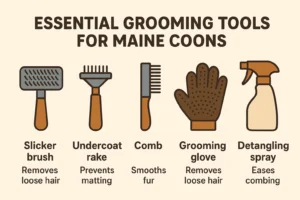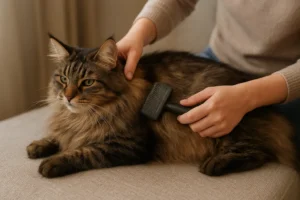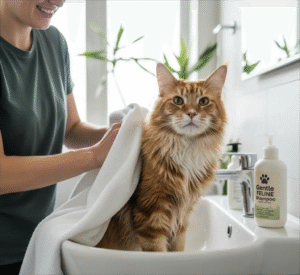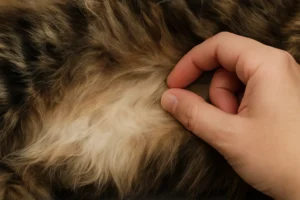Grooming a Maine Coon is not just about making them look good, it is also about keeping their coat healthy, their skin clean, and preventing painful mats. In this guide, I will share my decade long experience as a breeder, guiding you through exactly how to groom your Maine Coon at home, from brushing routines and bathing steps to choosing the right tools for their heavy double coat.
There is no mistaking a Maine Coon’s coat with any other house cat breed, because it is long, thick, and glorious. But that beauty comes with a price, which is the maintenance of the coat, it can be time consuming, and it can be fun at the same time.
How Often Should You Groom a Maine Coon?

There is no one size fits all grooming routine for all Maine Coon cats, i usually advise adopters that their Maine Coon’s grooming routine depends on the cat’s coat texture, age, and even the season. As a rule of of thumb, I personally aim for 2–3 brushing sessions per week, but increase the frequency to daily during shedding seasons (spring and fall).
Their thick double coat includes a soft underlayer that traps loose fur easily. If not brushed out regularly, it tangles near the armpits, belly, and tail base. Over time, those tangles turn into dense mats, which are not only uncomfortable but can pull on the skin.
You’ll notice your Maine Coon needs more frequent grooming when:
- You see small knots forming under the legs or belly.
- The coat looks dull, oily, or clumped.
- Your cat leaves excess fur tufts on furniture or sheds heavily.
During summer, some Maine Coons shed their dense winter undercoat, requiring extra brushing to help loosen it naturally. While in colder months, you can reduce grooming frequency slightly, focusing more on detangling and checking for dry skin instead.
Essential Grooming Tools for Maine Coons

Having the right tools makes grooming smoother and less stressful for both you and your cat. Maine Coons have long, multi-layered fur so not every brush will do the job.
1. Slicker Brush: A must-have for removing loose hair and surface tangles. Use gentle, short strokes to avoid scratching their skin.
2. Undercoat Rake or Dematting Comb: This tool reaches the dense underlayer to pull out dead fur. It helps prevent matting before it starts especially during shedding season.
3. Stainless Steel Comb: Perfect for finishing touches. Run it through the tail, chest, and ruff after brushing to catch any missed knots.
4. Grooming Gloves (for sensitive cats): If your cat dislikes brushes, grooming gloves can remove loose hair through gentle petting motions.
5. Detangling Spray & Cat Shampoo: It is very important that you find a hypoallergenic, cat-safe detangling spray or even a conditioner that will softens the fur therby making it easier combing (personally, i like the K9 Instant Dmatter Conditioner spray). Please, it is important to know never to use conditioners or sprays made for humans or dogs rather get those specifically made for cats.
6. Optional Tools:
- Trimming scissors (blunt tip for safety) for trimming paws or matted spots.
- Pet dryer or towel for post-bath drying.
- These tools make a huge difference in managing that heavy coat and keeping grooming enjoyable for your Maine Coon.
Maine Coon Grooming Routine
Grooming doesn’t have to be overwhelming, just build a steady, calm routine. Here’s how to handle each step safely and effectively.
1. Brushing and Detangling

Brushing and detangling is the most important step to grooming your cat, it would also determine the cat’s composure during the grooming process. Next, continue by slowly brushing the coat in the direction in which the fur is growing using a slicker brush, make sure to focus on high-shed areas, usually the belly, neck ruff, and tail.

While brushing, look out for mats, and if you find any, hold the base of the fur near the skin (to reduce pulling) and gently tease it apart with a comb or your fingers. Apply a small amount of detangling spray if needed, and never cut mats with scissors unless absolutely necessary.
Keep sessions short at first (5–10 minutes), and reward your cat after each session to build trust.
2. Bathing Your Maine Coon
Bathing is one of those things that is not required as often as grooming, which is recommended every 2–3 months, is enough unless your cat gets oily or dirty. Out of experience, i usually advise new cat owners to always brush thoroughly to remove loose fur.
It is also very important not to use cold water, but rather use lukewarm water and a mild, cat-formulated shampoo to bathe your cat. Gently lather from neck to tail, avoiding the face and ears. Rinse thoroughly, as leftover shampoo can cause skin irritation. Dry using a soft towel first, then let your cat air-dry or use a pet-safe dryer on low heat.
3. Trimming Around the Paws and Ears
Trimming your cat’s fur is a very important aspect you should pay attention to, as it helps with hygiene, especially around the paws, where fur collects dirt and litter. Use rounded-tip scissors to lightly trim excess fur sticking out between the toes or around the ear edges.
Never trim deep inside the ear canal stick to surface-level grooming. Regular trimming also prevents slipping on smooth floors and keeps your Maine Coon looking tidy.
4. Nail Clipping and Ear Cleaning
Clipping the cat’s nail should be an activity you do every 2-3 weeks, depending on the rate at which the nails grow and the size you wish to retain them at. While some cat breeders do not believe in clipping your cat’s nails, let alone clawing them off totally, you should always do the clipping using cat nail clippers and avoid the quick part found inside the nail.
For the ears, you can utilize ear wipes recommended by a vet or cotton cotton buds dampened with ear cleaning solutions safe for cats, wiping the outer ear area without ever inserting the object inside the ears. Brushing the nails and ears of your Maine coon ensures the cat remains clean and infection-free.
Common Grooming Mistakes to Avoid
Even with the best intentions, some grooming habits can backfire. Here’s what to avoid:
1. Over-Bathing: Frequent baths strip away natural oils that keep your cat’s coat healthy and shiny. Stick to occasional bathing unless your vet recommends otherwise.
2. Using Human or Dog Shampoo: These products contain ingredients that can dry out or irritate feline skin. Always use pH-balanced, cat-formulated shampoo only.
3. Brushing Too Aggressively: Maine Coon fur may look dense, but their skin is sensitive. Use slow, gentle strokes to avoid scratching or pulling.
4. Ignoring Problem Spots: Areas like the armpits, chest, and behind the ears tend to mat first. Regularly check these hidden zones a few seconds of brushing here can prevent hours of detangling later.
5. Skipping Grooming During Shedding Season: It might seem harmless to skip brushing for a few days, but that’s when fur mats quickly. Daily sessions in spring and fall make all the difference.
Consistent, mindful grooming helps prevent costly visits to a professional groomer or vet due to skin or matting issues.
When to Visit a Professional Groomer
If mats become too thick or your cat resists grooming entirely, it may be time to seek professional help. Groomers experienced with long-haired breeds can safely remove mats, trim coats, and even perform sanitary cuts to keep your cat comfortable.
Senior or rescue Maine Coons often need extra patience and expertise professionals can make that process stress-free.
A visit every 4–6 months to a skilled groomer helps keep your Maine Coon’s coat in top shape while you maintain it at home between sessions.
Seasonal Grooming Tips
A Maine Coon’s coat doesn’t stay the same year-round it changes with the seasons. Understanding how to adjust your grooming habits throughout the year keeps their coat healthier and easier to manage.
1. Shedding Season (Spring & Fall):
Twice every year, all Maine Coons shed their thick undercoat to prepare for temperature changes (I personally refer to this season as the get out of old clothes season). There is no escaping the spring and fall seasonal shedding, so it is important to brush your cat 3 times a week.
After brushing, it is now time to remove loose fur before it tangles, to achieve this, use an undercoat rake. Also, please note that regular grooming also reduces hairballs, a common issue during heavy shedding months.
2. Winter Grooming:
When temperatures drop, indoor heating can cause static and coat dryness, but this can quickly be fixed by lightly misting the fur with a cat-safe leave-in conditioner or detangling spray before brushing. It adds moisture and reduces static cling. Also, make sure your cat’s environment isn’t overly dry a small humidifier can help.
3. Indoor vs. Outdoor Maine Coons:
Outdoor cats often develop thicker coats due to natural temperature adaptation. They may shed more heavily in spring. Indoor Maine Coons, living in constant temperatures, tend to shed moderately all year, so regular brushing (2–3 times weekly) works best for them.

Adapting your grooming schedule to the season helps maintain coat health and keeps your Maine Coon comfortable all year long.
Other Resources You Might Like
When to Visit a Professional Groomer
Even with consistent at-home care, there are times when a professional groomer is your best option, especially for long-haired breeds like the Maine Coon.
1. When Mats Become Too Dense: If mats are thick, close to the skin, or cover large areas (belly, underarms, tail base), don’t try to cut or pull them yourself. Professional groomers have specialized tools and techniques to remove mats safely without hurting your cat or damaging their coat.
2. Signs of Stress or Aggression During Grooming: If your Maine Coon becomes anxious, growls, or resists brushing, it’s a sign of discomfort or fear. A groomer experienced with cats can handle the process calmly and safely, sometimes with the help of mild, vet-approved calming sprays.
3. Grooming Senior or Rescue Maine Coons: Generally, older or rescued cats may sometimes suffer from mobility issues or tangled coats that need gentle handling. In cases like this, i usually recommend booking a professional cat grooming service, as a professional groomer would know exactly how to support these cats physically while grooming to avoid pain or fatigue.
Final Thoughts
In a nutshell, grooming your Maine Coon cat is way more than just a beauty routine, it is part of caring for your cat’s health and happiness. Consistent brushing helps to prevent mats, minimizes shedding, and gives you a chance to check for fleas, bumps, or skin irritation early on.
When armed with the right cat grooming tools, gentle handling, and consistency, grooming time can even become a bonding ritual, speaking from a decade long experience of breeding these cats. After all, a well groomed Maine Coon is not just beautiful, they are more comfortable, confident, and ready to show off that magnificent coat you worked so hard to maintain.
